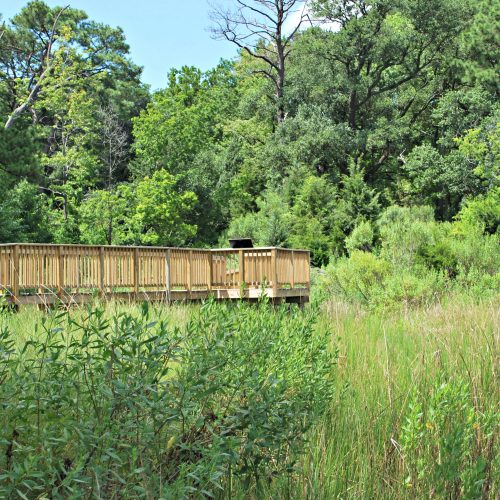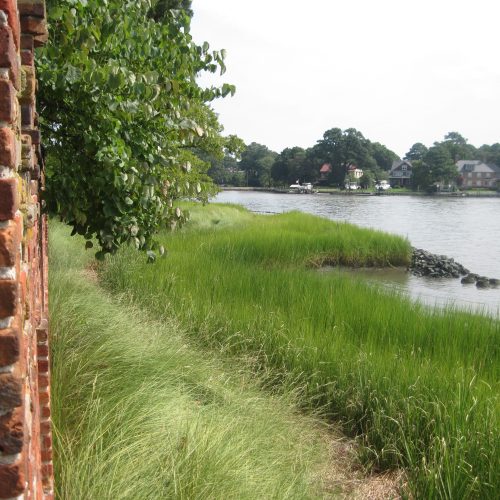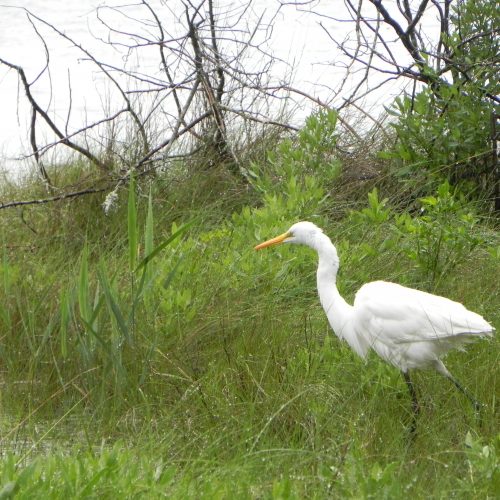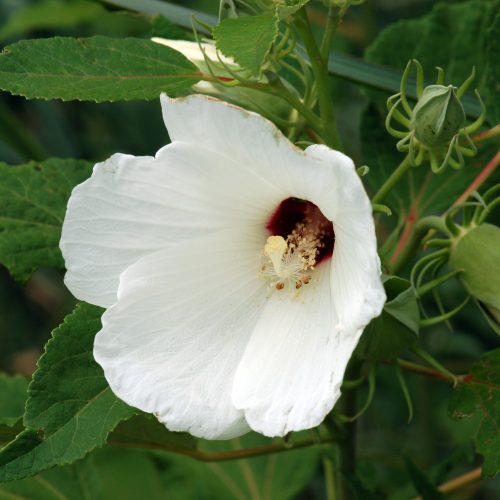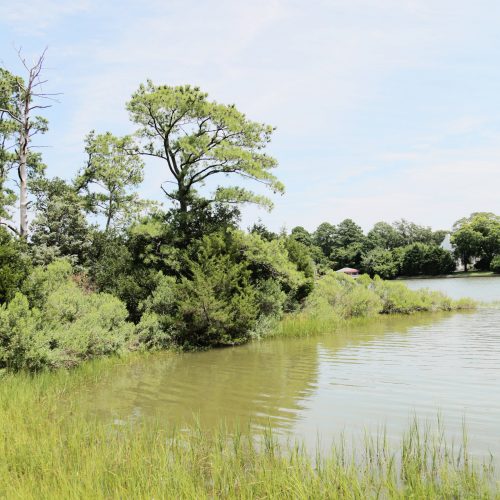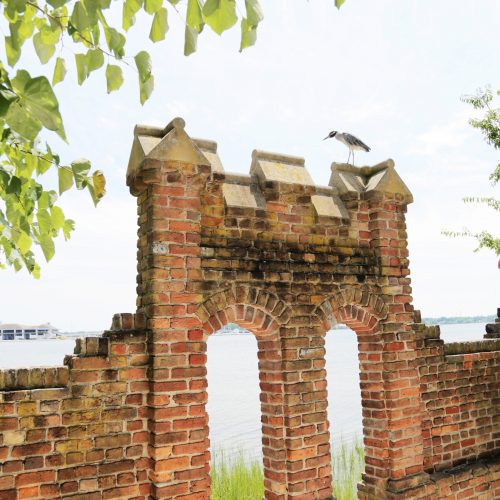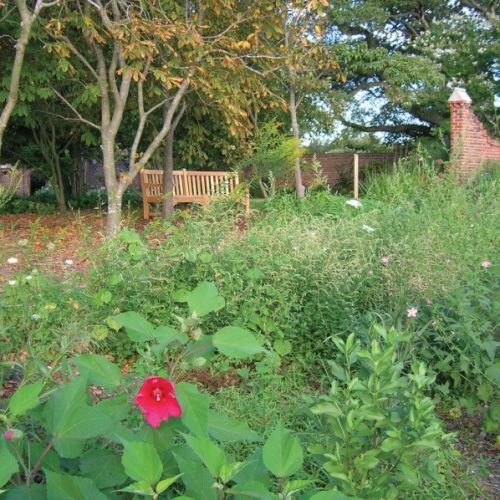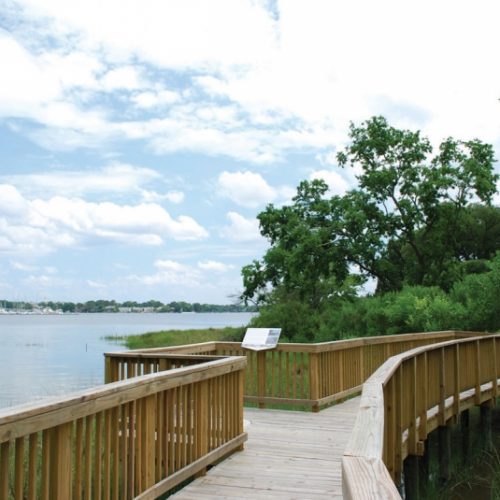Wetlands Restoration
Since 2006, a large scale wetlands restoration project began at the Hermitage. Over 5,000 native marsh grasses were planted, creating a ½-acre Living Shoreline on the east end of the Hermitage grounds. This project was a joint effort of the Hermitage, NOAA Restoration Center, the National Fish and Wildlife Foundation, the Elizabeth River Project, and the City of Norfolk; many local volunteers devoted hours of their time to the effort as well. This project assists in controlling erosion and has effectively created a safe and clean habitat for many species of fish and wildlife. The Hermitage Wetlands also include a variety of native and flowering plants. Guests can stroll along the boardwalk, where educational markers have been placed to help the public appreciate the importance that wetlands provide in sustaining a healthy, thriving ecosystem. The 180 foot boardwalk can be accessed from a path off the main drive or through entrances in the East Garden.
In the spring of 2011 we continued our efforts of preservation by restoring a ¼-acre part of the original wetlands to the west end of the property. This project involved the planting of native Spartina alterniflora and the use of coir logs to hold sand and imitate a natural shoreline.
Most recently 6,500 square feet of wetlands were restored on the west side of the property in the spring of 2015.
The Hermitage is recognized as a ‘Sustained Distinguished Performance River Star’ by the Elizabeth River Project’s River Stars Program. This represents the completion of significant new initiatives by a River Star and was earned for the Museum’s continued efforts in habitat enhancement, pollution prevention, and community outreach and education.
The award also reflects the educational efforts of the Museum involved with the restoration over the past year, including student plantings, community clean ups, and volunteer oyster bed enhancements. Additionally, efforts have been made to reduce the number of herbicides and pesticides used in the gardens by 50%.
Buffer Bed Plant List
| Herbaceous-perennial plants | ||
| Blue Vervain
Blue Wild Indigo Canada Goldenrod Cardinal Flower Cinnamon fern Jewelweed Joe Pye Weed |
Lizard’s tail
Marsh Hibiscus Marsh Marigold Monkey Flower New York Aster Pickerelweed Saltmarsh fleabane |
Sea Oxeye
Seashore Mallow Seaside Goldenrod Spiderwort Sundrops Swamp Milkweed Yellow Water Iris |
Grasses |
||
| Black Needlerush
Coastal Panic grass Rice Cutgrass |
Saltmeadow hay
Smooth cordgrass Soft Rush |
Switchgrass
Variegated Sweet Flag |
Shrubs |
||
| Beautyberry
Buttonbush Elderberry Groundsel bush |
Inkberry holly
Marsh elder Southern wax myrtle Swamp rose |
Sweet pepperbush
Witchhazel |
Trees |
|
| Carolina Silverbell
Virginia Sweetspire |
Sweetbay Magnolia
Tea Olive |
Oyster Reef Balls
Oysters are extremely important to the filtration of our waters; a single oyster can clean up to 50 gallons of water per day. Sadly, the number of oysters in the Chesapeake Bay has drastically declined over the past several years due to disease, over-fishing, and poor water quality. The re-population of these oysters is essential in restoring our local waterways.
In June 2010 and April 2012, the Chesapeake Bay Foundation installed 75 oyster reef balls throughout the Lafayette River. Reef balls are hollow spheres of concrete weighing around 100 pounds each. They provide a solid habitat on which oyster larvae, or ‘spat’, can attach and grow.
These oyster reef balls were installed near the Hermitage shoreline and at the mouth of the water breakers on the east and south sides of the property. Five months later the reef balls were examined and we had magnificent results! The reef balls were completely covered with oysters, signifying improved water conditions and a healthy local oyster population. Visit our wetlands by the East Garden at low tide to see the oyster reef balls for yourself.
Rain Garden
Rain Gardens are designed to help capture, channel, divert, and clean runoff water that comes from rain and storms. The rain garden built here at the Hermitage also filters and absorbs the water from high tides raised by the Lafayette River as well as rainwater runoff from roofs, concrete curbs, and compact lawns. It uses the landscape to slow down the amount of water lost in public drainage.The garden will benefit the environment and improve the local wildlife and plant habitats.
The rain garden was designed and planted in the fall of 2011. To echo nature, it was planted with 80% of native plants and shrubs. The garden will be shared with the community and offers educational features to instruct guests on how the garden works and how they can start their own.
The rain garden was made possible by the Garden Club of Norfolk with funding provided by the Garden Club of Virginia’s Bessie Bocock Carter Conservation Award.
Materials used to build the rain garden: filter cloth or underline, two types of gravel–river rock and roof rock and soil-Nutri green blend with sand.
| The following plants can be found in the rain garden: | ||
| American Beautyberry
Aromatic aster Beautyberry Bee balm Black Eyed Susan Blanket Flower Blue Star Cattail Chocolate Joe Pye Weed Coreopsis ‘Fruit Punch’ Early Amethyst Beautyberry False Aster Florida anise |
Hibiscus ‘Kopper King’
Hibiscus Sultry Kiss Little Joe Pye Weed Marsh elder Milkweed Mist flower New England Aster Panicum virgatum Pink Mulhy Grass Pink Snakeweed Red Fountain grass Red Knee High Salt bush |
Seashore Mallow
Seaside Goldenrod Shasta Daisy Solidago ‘Golden Fleece’ St John’s wort Swamp Milkweed Swamp rose Sweet Pepperbush Virginia Sweetspire Wax Myrtle White Gaura Winter Red Holly |
WET Program
Wetland’s Enrichment Tours, or WET, is a newly designed educational program aimed at bringing the Hermitage’s living shoreline restoration to life for Norfolk Public School students. The program, offered to students in grades four through six, teaches what a wetland is, creatures and features of wetlands, why wetlands are important, and the flood buffering and filtering effects of wetlands.

